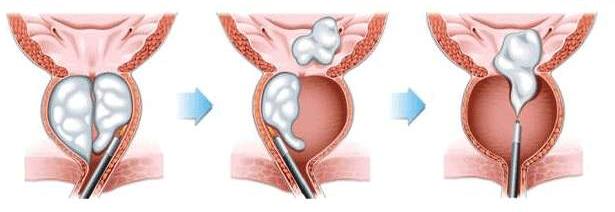TURP Surgery – trans- urethral resection of prostate, basically involves the insertion of an instrument through the urethra upto the prostate. TURP is often recommended when enlarged prostate syndrome is unresponsive to medications/ home remedies. TURP is often performed with a general or spinal anesthetic.
Types Of TURP Surgery:
- Mono-polar TURP:
- This is a conventional TURP which removes the enlarged prostate tissue, with the electric loop ‘s current flowing in a single direction, hence named mono-polar.
- Bi-polar TURP: A newer technique:
- This is a modern TURP which removes the enlarged prostate tissue, with the electric loop ‘s current flowing in a dual direction, hence named bi-polar.
- PK/ Button/ Plasmakinetic Resection:
- Here, a low voltage electric ionized vapor is used to vaporize the affected prostate inner tissue by heating a semi-spherical like button.
- This is the least invasive type of resection.
- And comparatively minimal complications and faster healing time.
Advantages:
- Better results.
- General/ spinal anasthesia.
- Safer modality.
- Better quality of life post-treatment.
- Surgery time: only 1 to 1 and half hour.
Symptoms:
- Obstructive urination.
- Inability to relieve urine.
- Frequent urination.
- Constant ache/ stiffness in lower back, hips, thighs.
- Blood in urine/ semen.
- Painful ejaculation/ troublesome erection.
- Painful/ burning during urination.
- Dribbling urine.
- Severe:
- Leaky bladder.
- Recurrent infections.
- Kidney damage.
Diagnosis Tests:
- Digital rectal exam.
- Blood/ Urine tests.
- Urine flow analysis.
- Cytoscopy.
- Ultrasound scan.
- Prostrate biopsy.
- Scrotal ultrasound- Doppler mode.
Preparation:
- Avoid blood thinning agents Plavix (clopidrogel) and Coumadin (Warfarin).
- With the consultation of your doctor, avoid pain relievers like ibuprofen/ naproxen sodium/ aspirin, etc.
- Avoid eating/ drinking after midnight.
- General/ spinal anansthesia.
Treatment:
- A surgical cum visual instrument named resectoscope is inserted through the tip of the penisand into the urethra to the prostate area.
- This way no cuts need to be made to access the prostate.
- Mono-polar TURP: The targeted site needs to be irrigated with non-conducting fluid so as to prevent the electrical current affecting the healthy surrounding tissues and thus avoid the TUR syndrome. Allows only short-procedure time.
- Bi-polar TURP: The targeted site is saline-irrigated so as to prevent the electrical current affecting the healthy surrounding tissues and thus avoid the TUR syndrome. Allows long procedure time.
- The resectoscope is facilitated with valves to control respective irrigated fluids, in order to cut the tissue & seal blood vessels it has an electrical loop, as well as a light to observe.
- With the help of this resectoscope’s electric loop, a bipolar electrical current is used to create an ionized energy for tissue vaporization, and thus the enlarged tissues inside the affected prostate glands are trimmed piece by piece, carried into the bladder by the irrigating fluids.
- These are completely removed at the end of the operation.
Risks:
- Hospitalization upto 1 to 2 days.
- Heavy blood in the urine.
- Blockage of urethra.
- Damaged kidney function.
- Laxatives maybe required.
- Catheterization may be required to avoid potential blood clots/ blood in the urine.
- Sudden low sodium blood levels.
- Dry orgasms.
- Erectile dysfunction.
- Difficult urination.
- Possibility of urinary tract infection.
Follow-up:
- Prostate tissue, after this treatment, is tested for the possible risk of cancer cells.
- Athletic supporter for pressure relief.
- Healthy diet and lifestyle.
- Avoid alcohol/ caffeine/ smoking.
- Avoid before bedtime fluids.
- Double voiding the bladder at a single visit.
- Relaxation therapy.
- Regular mild exercise avoid strenuous activity.
- Drink liquids in small amounts not large amounts at once.
- Don’t resist the urge to urinate.
- Avoid sexual activity for upto 6 weeks.
- Avoid decongestants.
- Avoid antihistamines.
- Regular check-up and tests.
- Prevention & precaution is better than cure.
All above, treatments are finalized taking into consideration the overall health, severity, age and other ailments of the patient.


